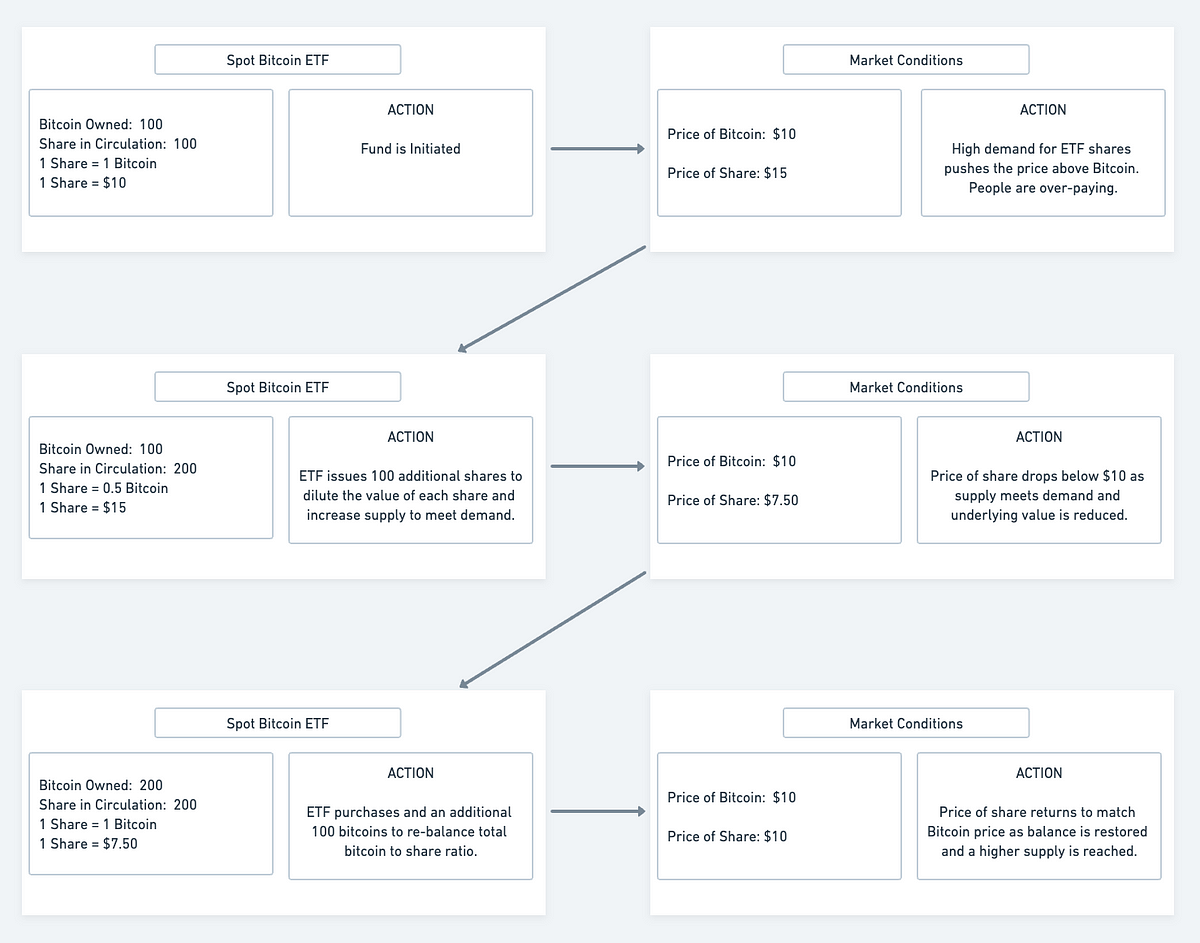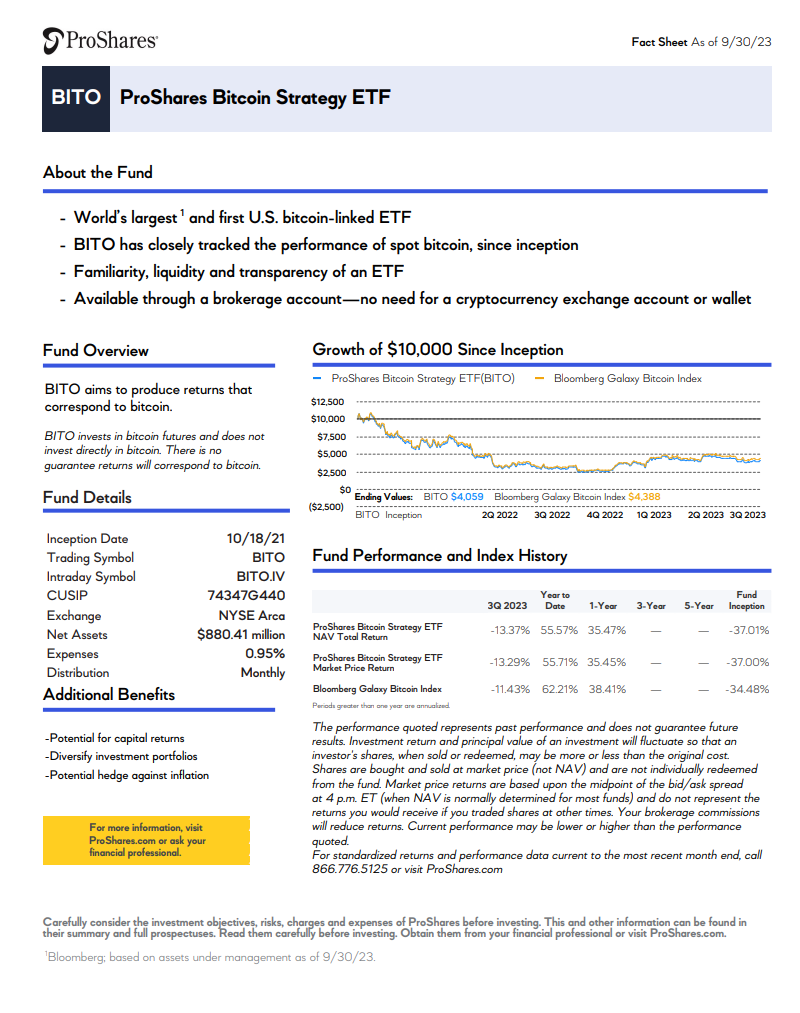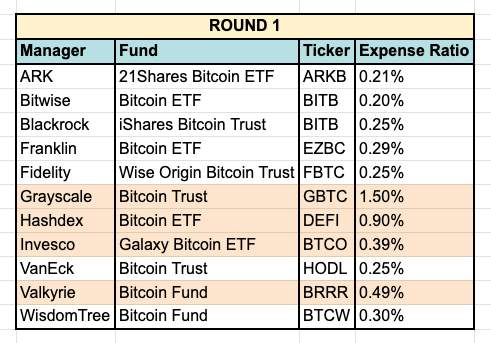- The Moneycessity Newsletter
- Posts
- BITCOIN ETF Explained and Ranked in 8 Minutes
BITCOIN ETF Explained and Ranked in 8 Minutes
We are going to talk about what a Bitcoin ETF is, how a spot Bitcoin ETF works, and is Bitcoin ETF approved. I will also share my pick for the best Bitcoin ETF among the 11 Spot Bitcoin ETFs that are approved in 2024, including details on ticker symbols, prices, and fees.
The Spot Bitcoin ETFs are not diversified like you might think.
If you have experience investing in stocks, then you are probably familiar with ETFs in that context. Just like traditional ETFs invest in many different companies, I was under the initial assumption that the spot Bitcoin ETFs would hold multiple cryptocurrencies, but that is not the case.
In less than 8 minutes, I'm going to explain:
What the spot Bitcoin ETFs do
How they're different from the existing Bitcoin ETFs
Which spot Bitcoin ETFs are the best to invest in?
On the go? Watch the video HERE.
The SEC approved 11 spot Bitcoin ETFs on January 10th, 2024. In the long term, this is really good for Bitcoin as a whole for three reasons:
The SEC approval is a vote of confidence, adding to the social acceptability of Bitcoin.
More money will come into Bitcoin as investing in ETFs is viewed as safer and more convenient and there are a lot of big names that offer these ETFs: BlackRock, Fidelity, and ARK to name a few.
Spot Bitcoin ETFs should be able to track Bitcoin more accurately than traditional Bitcoin ETFs.
So let me go ahead and answer the first question: What exactly do the Spot Bitcoin ETFs do?
What is Spot Bitcoin ETF?
Traditional ETFs that you're more familiar with hold many different companies, but Spot Bitcoin ETFs only hold one cryptocurrency, Bitcoin.
Believe it or not, these new ETFs are the first to do it. Other ETFs that came before did not have SEC approval to hold actual Bitcoins.
Spot Bitcoin ETFs purchase actual bitcoins from other users or exchanges and then hold those bitcoins in digital wallets with several layers of security.
The sole goal of these spot Bitcoin ETFs is to mirror the price of Bitcoin.
If Bitcoin goes up by 10%, they want their share price to go up by 10%.
If Bitcoin goes down by 10%, they want their share price to go down by 10%.
This is accomplished by issuing a set number of shares that corresponds to the number of Bitcoin. If demand is too high and the share price is the value of Bitcoin, they can issue new shares to dilute their current supply. This would result in the share price going down.
Let's do an example.

How Do Spot Bitcoins Get Their Value — Illustration by author
A hypothetical Bitcoin ETF holds 100 Bitcoins and issues 100 shares. For this example, let's assume a Bitcoin is worth $10 for easy math. That means that each share of the Spot Bitcoin ETF is worth $10.
If there is so much demand for this ETF, that 100 shares isn't enough, then people will be able to sell their shares for more than $10. The price of each share will then up to $15, although each share only accounts for just $10 in Bitcoin.
This is no good if the underlying price of Bitcoin is still $10. To handle both the increased demand and lower the price, the ETF can issue 100 more shares. This means that each share is now only worth half of a Bitcoin since there are 200 shares and only 100 Bitcoins.
Naturally, the price will start to fall as the increased share count can better handle the demand and each share has less underlying value. If the price starts to fall below $10 a share, then the ETF has two options.
Option 1
First, by using the extra cash gained from issuing additional shares, the ETF can increase the amount of Bitcoin it holds, which brings the Bitcoin per share back closer to one-to-one. But now there are more shares to handle the demand.
Option 2
The second way to rebalance is to buy back the extra shares and reduce the number of shares in circulation. This will also bring the Bitcoin per share back closer to one-to-one.

How Spot Bitcoin ETF Mimic Bitcoin Price
Just a minor note, the ETF itself isn't the one that issues and redeems shares. This is carried out by authorized participants, usually large banks, but that's a topic for another video.
So the main takeaway is that Spot Bitcoin ETFs purchase actual Bitcoins to better represent the cost of Bitcoin.
But how is that different from the previously existing Bitcoin ETFs or Bitcoin wallets and how is it better?
How is Spot Bitcoin ETF Different From Traditional Bitcoin ETF?
First of all, the previously existing Bitcoin ETFs are known as Bitcoin Futures ETFs with the first one to be approved by the SEC was ProShares Bitcoin Strategy ETF ticker BITO in October of 2021.
BITO would track the value of Bitcoin by purchasing Bitcoin futures contracts without holding 100% Bitcoin futures.
We can see that out of $880 million of the total assets, $497 million is held in treasury bills. ETFs like BITO rely on professionals to strategically buy and sell Bitcoin futures at the right time to properly mimic the price movements of Bitcoin.
As a result, the expense ratio of BITO is pretty high at 0.95%. Additionally, BITO can never be as accurate at mimicking the price movements of Bitcoin as an ETF that actually holds bitcoins.

What is a Futures Bitcoin
One way that I gained exposure to Bitcoin in the past was by buying through Robinhood. This way I could track the price of Bitcoin exactly because I owned an actual Bitcoin. However, there are some downsides, lack of security, for instance.
Since my Bitcoin is held in a digital wallet, there's a chance that the exchange could go down, it could get hacked, and I could lose my Bitcoin.
On the other hand, if you get your Bitcoin exposure through an ETF, then you benefit from SIPC insurance. Since Bitcoin is held on an exchange, if the exchange goes down or gets hacked, you could lose everything.
So let's get to the bottom line. Which of the spot Bitcoin ETFs are the best to invest in?
What Spot Bitcoin ETF is the Best?
Of course, I cannot see the future, but we can evaluate these 11 ETFs on three important criteria.
Round 1 — Expense Ratio
First and foremost, the number one goal of these Spot Bitcoin ETFs is to accurately track Bitcoin. All things being equal, whichever one does it for the cheapest is obviously the best.

11 SEC Approved Spot Bitcoins with Ticker and Expense Ratio — Spreadsheet by author
There's a pretty wide range of expense ratios. We can see the upper bound here is 1.5% per year and the lower bound is 0.2% per year.
Let's look and see what this means over a 20-year investing period.
Investing $50,000 with an average annual return of 10%, a 1.5% expense ratio means you're paying $80,783 throughout your investment, while with the 2% fee you're only paying $12,000. When we compare that to the total returns, this is about 32% of the total gains that you would get over 20 years if your expense ratio is 1.5%. That is way too high.
Next, let's compare the 0.3% fee to the 0.2%. In the same situation as before, you're paying $17,888 compared to the $12,000 of the lowest fee. When we compare this to our total gains, the 0.3% fee is about 5.5% of our total, while the 0.2% fee is 3.7% of our total gains.
Personally, 0.3% is the highest I would be willing to pay for a spot Bitcoin ETF. That eliminates 4 out of the 11 spot Bitcoin ETFs.

11 SEC Approved Spot Bitcoins Eliminated by Expense Ratio — Spreadsheet by author
The next criteria I want to look at is reputation. Out of these 11 spot ETFs, which asset manager has the strongest reputation and is thus the safest?
Round 2 — Reputation
The remaining ETFs range anywhere from $712 million up to $11.7 trillion in assets under management.
I'm going to eliminate any asset manager that has less than $1 trillion in assets under management. This is a proxy for an asset manager that is very popular, in business for a long and is thus very trustworthy.

11 SEC Approved Spot Bitcoins Eliminated by Reputation — Spreadsheet by author
This just leaves three spot Bitcoin ETFs: BlackRock, Franklin, and Fidelity.
Round 3
When comparing these final three, Franklin sticks out as worse than the rest. Not only does it have an order of magnitude lower assets under management, it also has a slightly higher expense ratio.

11 SEC Approved Spot Bitcoins Eliminated by Expense Ratio and Reputation— Spreadsheet by author
So I'm going to go ahead and just narrow this down to BlackRock and Fidelity.
Round 4 — Custodian
The final criteria I want to look at is how Bitcoin is stored.
Fidelity uses their own custodial service to store all the Bitcoin owned by their ETF. On the other hand, BlackRock has partnered with Coinbase, the largest cryptocurrency custodian in the United States.
Combining their reputation and customer base will likely result in a greater trading volume for BlackRock's Spot Bitcoin ETF, iBit.

11 SEC Approved Spot Bitcoins Eliminated by Custodian — Spreadsheet by author
Even though BlackRock's iBit is in a strong position to scoop up the majority of the Bitcoin ETF market share, the future value of Bitcoin is what you need to consider first and foremost.
In the end, it doesn't matter if you pick the best Bitcoin ETF if the value of Bitcoin crashes to zero. Click HERE if you want to get a better understanding of Bitcoin and where its value really comes from.
See you there!

Reply